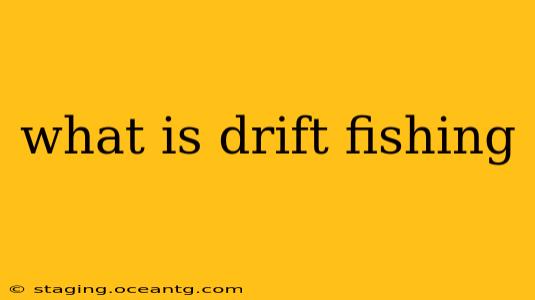Drift fishing is a popular and effective fishing technique where anglers allow their boat to drift naturally with the current or wind, while their lines are cast into the water. Unlike anchoring or trolling, drift fishing offers a unique approach to targeting fish that are moving with the water flow. This method is particularly effective in catching a variety of species, depending on location and the type of bait or lure used. This guide will delve into the details of drift fishing, answering many frequently asked questions.
How Does Drift Fishing Work?
The core principle of drift fishing is simple: let the boat drift, and fish with the current. Anglers cast their lines into the water, allowing the bait or lure to drift naturally, mimicking the movement of natural prey. The boat's movement, often slow and steady, helps to cover a wider area than stationary fishing methods. This subtle movement often triggers feeding responses in fish. The effectiveness depends heavily on understanding currents, wind patterns, and the behavior of the target species.
What Kind of Fish Can You Catch Drift Fishing?
Drift fishing is surprisingly versatile, allowing you to target a wide array of fish species. The success depends largely on your location, the type of bait used, and the depth of the water. Some common species caught using this method include:
- Salmon: Drift fishing is a classic method for salmon fishing in rivers and coastal waters.
- Trout: Drifting with appropriate lures or bait can be extremely effective for catching trout in lakes and rivers.
- Tuna: In certain areas and under the right conditions, drift fishing can yield impressive catches of tuna.
- Grouper: Drifting over rocky reefs can be a successful method to target grouper.
- Cod: Drift fishing is used extensively for cod fishing in various parts of the world.
This list isn't exhaustive; many other species can be successfully targeted using drift fishing techniques.
What Equipment Do You Need for Drift Fishing?
The equipment needed for drift fishing can vary depending on the target species and fishing location. However, some essential items include:
- Boat: A boat is essential for drift fishing, ideally one that can drift naturally without too much effort.
- Fishing Rods and Reels: The choice of rod and reel will depend on the target species and the weight of the bait or lure.
- Line: Strong and durable line is crucial, able to withstand the forces of the current and the potential for larger fish.
- Bait or Lures: The choice of bait or lure will significantly impact the success of your drift fishing expedition. Live bait is often very effective, but artificial lures can also be highly successful.
- Anchors (Optional): While not always essential, anchors can be useful for controlled drifting or holding position in specific areas.
- Depth Finder: A depth finder is beneficial for identifying promising fishing spots and tracking the depth of your bait.
What are the Advantages of Drift Fishing?
Drift fishing presents several advantages over other fishing methods:
- Covers More Ground: The natural drift of the boat allows you to cover a wider area and explore various sections of the water.
- Mimics Natural Prey: The slow and natural movement of the bait or lure often triggers a feeding response in fish.
- Less Equipment: Compared to trolling, drift fishing often requires less sophisticated equipment.
- Relaxing and Engaging: Many anglers find drift fishing to be a relaxing and engaging way to enjoy the outdoors.
What are the Disadvantages of Drift Fishing?
While effective, drift fishing does have some limitations:
- Dependence on Current and Wind: The success of drift fishing is largely dependent on favorable current and wind conditions.
- Less Control: You have less direct control over the location of your bait compared to anchoring or trolling.
- Potential for Snags: Depending on the bottom structure, there is a risk of snagging your line.
Is Drift Fishing Suitable for Beginners?
Drift fishing is a relatively accessible method that can be enjoyed by both beginners and experienced anglers. Beginners should focus on mastering the basics of casting and line management, understanding the currents, and choosing appropriate bait or lures. With some practice and patience, anyone can successfully drift fish.
Where Can I Go Drift Fishing?
Drift fishing opportunities exist worldwide, in rivers, lakes, and coastal waters. The best locations will depend on the target species and local regulations. Researching local fishing spots and regulations is crucial before heading out.
This comprehensive guide should give you a strong understanding of drift fishing. Remember to always respect local regulations and practice responsible fishing. Tight lines!
